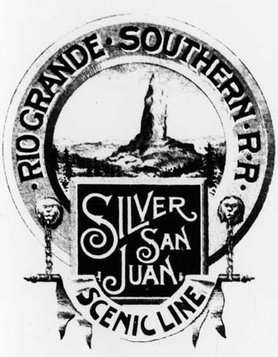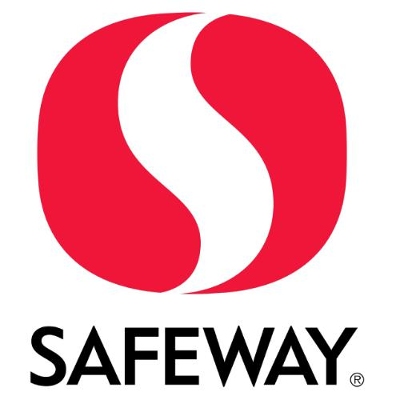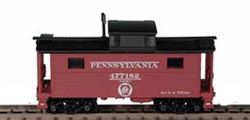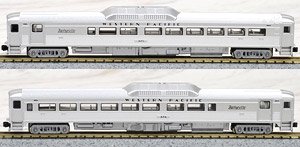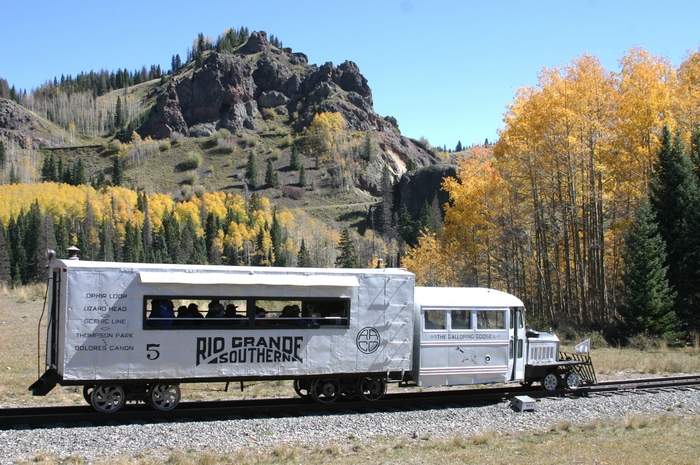Model Information: Introduced in 2006 (DC - $179.98) and 2007 (DCC - $198.98). No other runs since then. Packaged as "The Rail Baron Collection. A Collector's Edition"
Despite being really tiny, this model runs very smoothly.
All eight box trailer wheels provide pickup (no traction tires). Propulsion is provided solely by the two axles on the forward box trailer truck. The cab wheels are electrically neutral.
This is a N gauge model, not a Nn3 narrow gauge like the prototype.
This model is a replica of Rio Grande Southern (RGS) Motor #5 in its original configuration (freight). All other roadnames but RGS are fantasy, as the prototype was only built and used by the RGS. All non RGS versions are marked with road number X-105 and MoW (Maintenance of Way).
Despite being really tiny, this model runs very smoothly.
All eight box trailer wheels provide pickup (no traction tires). Propulsion is provided solely by the two axles on the forward box trailer truck. The cab wheels are electrically neutral.
This is a N gauge model, not a Nn3 narrow gauge like the prototype.
This model is a replica of Rio Grande Southern (RGS) Motor #5 in its original configuration (freight). All other roadnames but RGS are fantasy, as the prototype was only built and used by the RGS. All non RGS versions are marked with road number X-105 and MoW (Maintenance of Way).
DCC Information: First release was DC-only. Second release was with a built-in DCC decoder. Note that both versions are using similar stock numbers (difference is a 0 or a 9 as 2nd character) and can be distinguished by the mention "Standard DC Version" or "Dual Mode DC+DCC Version" on the sticker on the side of the package.
Prototype History: Galloping Goose is the popular name given to a series of seven railcars (officially designated as "motors" by the railroad), built in the 1930s by the Rio Grande Southern Railroad (RGS) and operated until the end of service on the line in the early 1950s.
Motors #1 and #2 were built from a Buick "Master Six" four-door sedan.
Motors #3 and #4 were built from a Pierce-Arrow 1926 body and Pierce-Arrow 33 engine.
Motor #5 was built from a Pierce-Arrow 1928 body and Pierce-Arrow 36 engine.
Motor #6 was built from a Buick body and a Buick-6 engine.
Motor #7 was built from a Pierce-Arrow 1926 body and a Ford 1936 V-8.
All but #1 have been preserved and are visible in various museums in Colorado. All the surviving units have been restored and are operational.
From Wikipedia.
Motors #1 and #2 were built from a Buick "Master Six" four-door sedan.
Motors #3 and #4 were built from a Pierce-Arrow 1926 body and Pierce-Arrow 33 engine.
Motor #5 was built from a Pierce-Arrow 1928 body and Pierce-Arrow 36 engine.
Motor #6 was built from a Buick body and a Buick-6 engine.
Motor #7 was built from a Pierce-Arrow 1926 body and a Ford 1936 V-8.
All but #1 have been preserved and are visible in various museums in Colorado. All the surviving units have been restored and are operational.
From Wikipedia.
Road Name History: 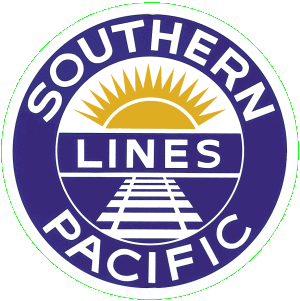 The Southern Pacific Transportation Company (reporting mark SP), earlier Southern Pacific Railroad and Southern Pacific Company, and usually called the Southern Pacific or (from the railroad's initials) Espee, was an American Class I railroad. It was absorbed in 1988 by the company that controlled the Denver and Rio Grande Western Railroad and eight years later became part of the Union Pacific Railroad.
The Southern Pacific Transportation Company (reporting mark SP), earlier Southern Pacific Railroad and Southern Pacific Company, and usually called the Southern Pacific or (from the railroad's initials) Espee, was an American Class I railroad. It was absorbed in 1988 by the company that controlled the Denver and Rio Grande Western Railroad and eight years later became part of the Union Pacific Railroad.
The railroad was founded as a land holding company in 1865, later acquiring the Central Pacific Railroad by lease. By 1900 the Southern Pacific Company was a major railroad system incorporating many smaller companies, such as the Texas and New Orleans Railroad and Morgan's Louisiana and Texas Railroad. It extended from New Orleans through Texas to El Paso, across New Mexico and through Tucson, to Los Angeles, through most of California, including San Francisco and Sacramento. Central Pacific lines extended east across Nevada to Ogden, Utah, and reached north through Oregon to Portland. Other subsidiaries eventually included the St. Louis Southwestern Railway (Cotton Belt), the Northwestern Pacific Railroad at 328 miles (528 km), the 1,331 miles (2,142 km) Southern Pacific Railroad of Mexico, and a variety of 3 ft (914 mm) narrow gauge routes.
In 1929 SP/T&NO operated 13848 route-miles not including Cotton Belt, whose purchase of the Golden State Route circa 1980 nearly doubled its size to 3,085 miles (4,965 km), bringing total SP/SSW mileage to around 13,508 miles (21,739 km).
By the 1980s route mileage had dropped to 10,423 miles (16,774 km), mainly due to the pruning of branch lines. In 1988 the Southern Pacific was taken over by D&RGW parent Rio Grande Industries. The combined railroad kept the Southern Pacific name due to its brand recognition in the railroad industry and with customers of both constituent railroads. Along with the addition of the SPCSL Corporation route from Chicago to St. Louis, the total length of the D&RGW/SP/SSW system was 15,959 miles (25,684 km).
By 1996 years of financial problems had dropped SP's mileage to 13,715 miles (22,072 km), and it was taken over by the Union Pacific Railroad.
Read more on Wikipedia.

The railroad was founded as a land holding company in 1865, later acquiring the Central Pacific Railroad by lease. By 1900 the Southern Pacific Company was a major railroad system incorporating many smaller companies, such as the Texas and New Orleans Railroad and Morgan's Louisiana and Texas Railroad. It extended from New Orleans through Texas to El Paso, across New Mexico and through Tucson, to Los Angeles, through most of California, including San Francisco and Sacramento. Central Pacific lines extended east across Nevada to Ogden, Utah, and reached north through Oregon to Portland. Other subsidiaries eventually included the St. Louis Southwestern Railway (Cotton Belt), the Northwestern Pacific Railroad at 328 miles (528 km), the 1,331 miles (2,142 km) Southern Pacific Railroad of Mexico, and a variety of 3 ft (914 mm) narrow gauge routes.
In 1929 SP/T&NO operated 13848 route-miles not including Cotton Belt, whose purchase of the Golden State Route circa 1980 nearly doubled its size to 3,085 miles (4,965 km), bringing total SP/SSW mileage to around 13,508 miles (21,739 km).
By the 1980s route mileage had dropped to 10,423 miles (16,774 km), mainly due to the pruning of branch lines. In 1988 the Southern Pacific was taken over by D&RGW parent Rio Grande Industries. The combined railroad kept the Southern Pacific name due to its brand recognition in the railroad industry and with customers of both constituent railroads. Along with the addition of the SPCSL Corporation route from Chicago to St. Louis, the total length of the D&RGW/SP/SSW system was 15,959 miles (25,684 km).
By 1996 years of financial problems had dropped SP's mileage to 13,715 miles (22,072 km), and it was taken over by the Union Pacific Railroad.
Read more on Wikipedia.
Brand/Importer Information: Con-Cor has been in business since 1962. Many things have changed over time as originally they were a complete manufacturing operation in the USA and at one time had upwards of 45 employees. They not only designed the models,but they also built their own molds, did injection molding, painting, printing and packaging on their models.
Currently, most of their manufacturing has been moved overseas and now they import 90% of their products as totally finished goods, or in finished components. They only do some incidental manufacturing today within the USA.
Important Note: The Con-Cor product numbering can be very confusing. Please see here in the article how to properly enter Con-Cor stock numbers in the TroveStar database.
Currently, most of their manufacturing has been moved overseas and now they import 90% of their products as totally finished goods, or in finished components. They only do some incidental manufacturing today within the USA.
Important Note: The Con-Cor product numbering can be very confusing. Please see here in the article how to properly enter Con-Cor stock numbers in the TroveStar database.
Item created by: Alain LM on 2018-08-16 06:00:49. Last edited by CNW400 on 2020-06-16 23:01:07
If you see errors or missing data in this entry, please feel free to log in and edit it. Anyone with a Gmail account can log in instantly.
If you see errors or missing data in this entry, please feel free to log in and edit it. Anyone with a Gmail account can log in instantly.




